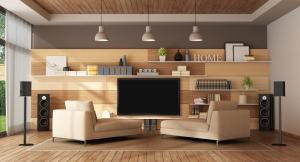Understanding the Differences Between Media Rooms and Home Theaters, Says Louisiana Audio Expert
Don Tucker, owner of D&D Audio and Video Solutions in Slidell, Louisiana, has seen a growing demand for both configurations, each offering distinct advantages depending on the goals of the project.
“Media rooms are designed for flexibility and multi-purpose use, while home theaters are built around immersive sound and acoustics in a controlled environment,” said Tucker.
A media room is typically an open or semi-open space that shares functionality with other activities. It may be located in a living room, bonus room, or family den. Seating is often casual and varied—ranging from sectionals to lounge chairs—and the space may include windows or high ceilings that contribute to ambient light and sound challenges. The layout supports group interaction, social gatherings, gaming, and television viewing.
In contrast, a home theater is a purpose-built room focused entirely on the entertainment experience. It is usually enclosed, acoustically treated, and isolated from external distractions. The seating layout is structured in rows, often with reclining theater chairs or tiered platforms for optimal sound direction and comfort. The lighting is controlled through dimmers, blackout shades, or wall sconces to enhance focus and minimize reflection.
The difference in design directly impacts equipment selection and audio performance. In a home theater, sound is engineered to deliver immersive experiences. Speaker placement, subwoofer calibration, and room acoustics are measured and tuned for consistent, balanced audio across all seating positions. These rooms often include architectural modifications to eliminate echo, manage low-frequency sound, and block noise from adjoining rooms.
Media rooms, on the other hand, must accommodate a wider range of use cases. Sound systems in media rooms tend to prioritize clarity and coverage over total immersion. The layout may need to support conversations, background audio, or light music in addition to entertainment. Because media rooms are often integrated into larger living spaces, sound may spill into adjacent areas or compete with other home activities.
Installation also varies between the two formats. Home theaters require more infrastructure—dedicated wiring, soundproofing materials, and structural customization. Media rooms often use existing room features and adapt to the layout already in place. This difference affects the construction timeline and planning process.
Lighting control is another differentiator. A home theater includes task-specific lighting with dimming zones and low-reflective surfaces to prevent distractions. Media rooms may rely on overhead fixtures, windows, or mixed-use lighting plans that support both daytime and nighttime activities. While lighting can be customized in either setting, its purpose in each case is distinct.
Control systems for both environments may include centralized remotes, wall panels, or app-based automation. In home theaters, controls are often fine-tuned to manage specific audio settings and room behavior. Media room controls are generally broader in scope and may integrate with smart home systems, adjusting settings for different users or activities.
Furniture layout also signals the intended purpose of the room. In a home theater, every seat faces forward, aligned for direct sound projection and central focus. In a media room, seating arrangements can be circular, L-shaped, or modular—allowing guests to face each other or the entertainment source, depending on the moment.
Room construction and acoustic treatment in a home theater are more intensive. Builders may install sound insulation within walls, acoustic panels, ceiling treatments, and door seals to minimize outside interference. Media rooms usually involve more compromise, adapting to an existing space without extensive modifications. As a result, audio performance is optimized to the degree possible within those limitations.
Budget planning is another consideration. Home theaters involve a detailed design process, including system engineering, architectural adjustments, and calibration. Media rooms tend to be more budget-flexible, with the option to scale up or down based on priorities such as sound, furniture, or integrated features.
Both options offer benefits, and the choice often comes down to lifestyle and intended use. Homeowners seeking a dedicated entertainment escape with isolated audio, mood lighting, and optimized layout may lean toward a home theater. Those looking for a more casual, multi-purpose environment that supports family activities and entertainment equally may opt for a media room.
Understanding these differences before starting a project allows for clearer expectations, better equipment selection, and a more satisfying end result. Each space serves a purpose, and with the right planning, either can deliver a high-performance entertainment environment.
Morgan Thomas
Rhino Digital, LLC
+1 504-875-5036
email us here
Visit us on social media:
Facebook
Legal Disclaimer:
EIN Presswire provides this news content "as is" without warranty of any kind. We do not accept any responsibility or liability for the accuracy, content, images, videos, licenses, completeness, legality, or reliability of the information contained in this article. If you have any complaints or copyright issues related to this article, kindly contact the author above.
Huntington’s Disease: Charting a New Path with Disease-Modifying Therapies and Strategic Innovation
Paramount Wellness Retreat Addresses the Link Between ADHD and Addiction with Specialized Dual Diagnosis Treatment
Aspire Systems wins Silver Stevie® Award in 2025 American Business Awards®
Kalendarium
Więcej ważnych informacji
 Jedynka Newserii
Jedynka Newserii

 Jedynka Newserii
Jedynka Newserii

Handel

Ze względu na różnice w cenach surowce wtórne przegrywają z pierwotnymi. To powoduje problemy branży recyklingowej
Rozporządzenie PPWR stawia ambitne cele w zakresie wykorzystania recyklatów w poszczególnych rodzajach opakowań. To będzie oznaczało wzrost popytu na materiały wtórne pochodzące z recyklingu. Obecnie problemy branży recyklingu mogą spowodować, że popyt będzie zaspokajany głównie przez import. Dziś do dobrowolnego wykorzystania recyklatów nie zachęcają przede wszystkim ceny – surowiec pierwotny można kupić taniej niż ten z recyklingu.
Przemysł spożywczy
Rośnie presja konkurencyjna na unijne rolnictwo. Bez rekompensat sytuacja rolników może się pogarszać

Rolnictwo i żywność, w tym rybołówstwo, są sektorami strategicznymi dla UE. System rolno-spożywczy, oparty na jednolitym rynku europejskim, wytwarza ponad 900 mld euro wartości dodanej. Jego konkurencyjność stoi jednak przed wieloma wyzwaniami – to przede wszystkim eksport z Ukrainy i niedługo także z krajów Mercosur, a także presja związana z oczekiwaniami konsumentów i Zielonym Ładem. Bez rekompensat rolnikom może być trudno tym wyzwaniom sprostać.
Transport
Infrastruktury ładowania elektryków przybywa w szybkim tempie. Inwestorzy jednak napotykają szereg barier

Liczba punktów ładowania samochodów elektrycznych wynosi dziś ok. 10 tys., a tempo wzrostu wynosi ok. 50 proc. r/r. Dynamika ta przez wiele miesięcy była wyższa niż wyniki samego rynku samochodów elektrycznych, na które w poprzednim roku wpływało zawieszenie rządowych dopłat do zakupu elektryka. Pierwszy kwartał br. zamknął się 22-proc. wzrostem liczby rejestracji w ujęciu rocznym, ale kwiecień przyniósł już wyraźne odbicie – o 100 proc.
Partner serwisu
Szkolenia

Akademia Newserii
Akademia Newserii to projekt, w ramach którego najlepsi polscy dziennikarze biznesowi, giełdowi oraz lifestylowi, a także szkoleniowcy z wieloletnim doświadczeniem dzielą się swoją wiedzą nt. pracy z mediami.










.gif)

 |
| |
| |
|